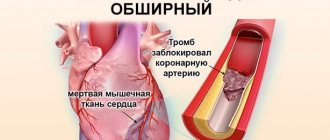Many heart problems are “masked” as pain in completely different parts of the body or just a slight malaise. Meanwhile, the query “signs of a heart attack” is one of the most popular in search engines. How is it that people simply cannot recognize a problem in a vital organ, yet heart disease continues to kill up to 18 million people of all ages every year?
What is a “silent” heart attack, how to recognize it and how to prevent it, AiF.ru was told by cardiologist of the Consultative and Diagnostic Department of the Federal Center for Brain and Neurotechnology of the FMBA of Russia, a doctor of the highest category, Candidate of Medical Sciences Galina Lazarenko .
How long does a heart attack last without medical attention?
A heart attack and its symptoms can vary in onset, intensity and duration.
Some may start suddenly, others slowly. They can last from a few minutes to several hours. Untreated heart attack symptoms can lead to serious complications or even death. Therefore, it is important to get prompt treatment after symptoms appear.
This article explains how long a heart attack can last. It also covers the symptoms of a heart attack and how and when to seek treatment.
How long can a heart attack last?
Symptoms of a heart attack usually last longer than a few minutes. They may go away and come back again, or they may occur intermittently over several hours.
In most cases, symptoms come on slowly and cause mild pain or discomfort. However, sometimes symptoms can be sudden and severe.
Chest pain that lasts several weeks or months is unlikely to be a heart attack or other life-threatening situation.
However, it is vital to start taking action as soon as symptoms appear.
Heart attack: symptoms
Symptoms of a heart attack can vary. Some common symptoms of a heart attack include:
- chest pain or pressure
- feeling dizzy or faint
- dyspnea
- cold sweat
- nausea
- indigestion
- fatigue
- pain that may spread to: arms
- back
- jaw
- neck
- upper abdomen
- shoulders
The more signs and symptoms, the higher the likelihood of a heart attack.
Among women
Women are less likely than men to experience severe chest pain. In some cases, there is no chest discomfort.
Instead, they may develop some other heart attack symptoms, such as shortness of breath or fatigue.
Signs of a heart attack
Signs of a heart attack
The main manifestations are characterized by:
- Prolonged chest pain that is not relieved by nitroglycerin.
- Shortness of breath, sudden severe weakness, cold, sticky sweat.
- A feeling of fear, even to the point of psychosis. The person completely loses control over his actions.
- Increased body temperature.
- Reducing criticism of your condition.
- Thread-like pulse, drop in blood pressure.
Heart attack: risks if you refuse treatment
If left untreated, a heart attack can cause serious complications. It may even be fatal.
Cardiovascular disease is the leading cause of death worldwide, with 85% of these deaths in 2021 due to a heart attack or stroke.
According to the Society of Cardiovascular Angiography and Interventions, there is approximately 90 minutes between the onset of a heart attack and treatment to prevent damage to critical heart tissue.
Complications
During a heart attack, blood flow to the heart is stopped due to a blockage in the coronary artery. These are the arteries that carry blood to the heart. If not treated immediately, the lack of blood flow can cause heart damage.
Complications arising from this situation include:
- Arrhythmia : abnormal heartbeat.
- Cardiogenic shock : severe damage to the heart muscle.
- Heart failure : This occurs when the heart can no longer pump blood effectively throughout the body.
According to the National Health Service (NHS), many die suddenly from such complications - some before they get to hospital and others within the first month of a heart attack.
The longer a heart attack goes untreated, the more damage it causes and the worse the outcome.
Location of the heart
Location of the heart in the body
Let's consider in detail:
The heart is a hollow muscular organ with an approximate weight of 250-300 grams, located at the level of 5-8 thoracic vertebrae with a predominant displacement to the left half of the chest, and has four chambers in its structure, separated by thick muscular partitions. Between these partitions are the heart valves, which allow blood to flow in only one direction. The size of the heart can increase as a result of the development of a number of certain diseases, as well as during intense physical activity, for example, when playing sports.
The heart has reliable protection - the pericardial sac or pericardium. This is the top layer of the heart wall. Next comes the dense muscle layer or myocardium. The inner lining of the heart is called the endocardium.
Our heart constantly needs nutrition in the form of oxygen and nutrients. This nutrition is provided by the coronary vessels through the circulatory system, in which the heart performs the pumping function. As we see, the heart is a complexly organized organ that contracts continuously, with short pauses for rest, which are measured in seconds. Therefore, this organ requires careful treatment and regular examination, especially after 40 years.
The classification of heart diseases is quite large, ranging from various heart rhythm disturbances, inflammatory diseases of the membranes, hypertension, malformations (congenital or acquired), heart vascular diseases and ending with acute vascular disorders that develop mainly against the background of coronary heart disease, which we will talk about in this article.
Heart disease has become younger. Nowadays you won’t surprise anyone with “young” heart attacks, which are more common in men even at the age of twenty.
Seeking Emergency Medical Care
Someone should call 911 immediately if they or someone else experiences symptoms of a heart attack. Even if you are not sure, you should still seek emergency care.
By calling an ambulance, you can begin treatment immediately after the ambulance arrives.
According to the American Heart Association (AHA), calling an ambulance allows you to start treatment an hour earlier than going to the hospital on your own. Those arriving by ambulance may also receive faster treatment in hospital.
Waiting for an ambulance
You can take an aspirin tablet, ideally 300 milligrams, while waiting for an ambulance.
Aspirin is a blood thinner that helps restore blood flow to the heart.
You should make sure you take all prescribed heart medications as directed while you wait for the ambulance to arrive. These medications may include nitroglycerin or beta blockers.
First aid
First aid:
On this topic ▼
How to call an ambulance or intensive care unit correctly
- Call an emergency team immediately.
- Calm yourself or calm the victim. Allow him to take a position that is comfortable for you (optimally in a lying position).
- Take a nitroglycerin tablet under the tongue. This can be done three times, with an interval of 5 minutes.
- Provide the victim with a flow of fresh air, unfasten the collar and belt.
- If the arrival of doctors is delayed and the pain is unbearable, you should take an analgin tablet.
- Measure the victim’s pulse and blood pressure every 5 minutes.
- Talk, encourage the person, introduce a set of distracting procedures (put the victim’s legs in a basin of warm water or place heating pads on the calf muscles).
Attention! For elderly and senile people, an attack of myocardial infarction can be painless!! This, in most cases, makes it very difficult to make a diagnosis.
Always remember that a person’s life depends on your quick and decisive actions.
But, as you know, a person is the master of his own destiny and his health. A few simple preventive measures that should go with you throughout life will help you maintain a healthy heart into old age.
Treatment
Treatment will depend on the type of heart attack.
In most cases, doctors treat heart attacks with catheterization and placement of a stent. Catheterization involves inserting a tube into the heart through a small incision in the groin or arm. The stent holds the artery open.
Immediate treatment
Forms of immediate hospital treatment may include:
- Aspirin: Prevents further blood clotting.
- Nitroglycerin: Helps improve blood flow.
- Oxygen therapy: Helps increase oxygen levels.
- Treatment for chest pain: Reduces pain or discomfort.
Surgery
Surgery can help restore blood flow to the heart. Surgical procedures for heart attack patients include bypass surgery. Bypass surgery involves redirecting blood flow around the blockage.
Some also consider catheterization and stent placement to be a form of surgery.
Medicines
The doctor may give the patient medications to dissolve the clot. Medicines that dissolve blood clots are called thrombolytics.
Your doctor may later prescribe other medications to reduce your risk of future heart attacks, including:
- aspirin or other blood thinners
- beta blockers
- ACE inhibitors
Recovery
The time it takes to recover from a heart attack varies. This depends on several factors, including your overall health and the amount of damage to the heart muscle caused by the heart attack.
Most people have to stay in the hospital for at least several days after a heart attack. Those who have bypass surgery will need to stay longer—sometimes a week or more.
Some may be able to return to work and other activities within 2 weeks, while others will take several months to recover.
Prospects
Most recover from a heart attack, especially if they receive emergency medical care.
The survival rate for heart attacks is now 90%. This is because doctors are now much more able to diagnose and treat heart attacks. Therefore, immediate medical attention is critical.
It is also extremely important to use preventive methods. This may help reduce the risk of heart attacks in the future.
Receiving Prescriptions
If you have a myocardial infarction, it is usually diagnosed by emergency physicians, or less often when visiting a doctor. After a heart attack, it is recommended to take care of yourself and be attentive to your health: early post-infarction angina leads to repeated heart attacks.
If you are interested in reducing your risk of heart attack, talk to your cardiologist about risk factors and ways to prevent heart attacks.
Since doctor's orders can be laconic and not always clear, it is a good idea to prepare for a consultation with a cardiologist. Below is information to help you prepare for your doctor's orders.
Prevention
There are many ways to reduce your risk of having a first or subsequent heart attack. These include:
- to give up smoking
- adopting a heart diet
- regular physical activity
- treatment of related conditions such as: diabetes mellitus
- high blood pressure
- chronic kidney disease
- high cholesterol
Risk group
In the risk group for the development of such pathology, Galina Lazarenko identifies:
- overweight people;
- those who suffer from high blood pressure;
- smokers;
- those diagnosed with diabetes;
- suffering from lipid metabolism disorders;
- those with low physical activity;
- people suffering from frequent stress.
“These factors are modifiable, which means people can influence them and minimize the risk of disease,” says Galina Lazarenko.
At the same time, the cardiologist notes that the risk group also includes people at risk of having a “silent” heart attack for reasons beyond their control. These include:
- men - according to statistics, “silent” myocardial infarction in men occurs 5 times more often than in women;
- people over 40 years old;
- people with a hereditary predisposition;
- people who have previously had a heart attack.
Article on the topic
Running from a heart attack. Is it true that sports are good for a diseased heart?
Conclusion
Symptoms of a heart attack can appear immediately and last several hours.
However, they can vary greatly in their presentation, onset and duration. Some symptoms appear suddenly, while others begin gradually.
As soon as you notice symptoms, you should call emergency services and take an aspirin tablet (unless you are allergic to aspirin and have been instructed to do so by a healthcare professional). Getting immediate medical help is the best way to improve your condition.
With prompt treatment, most recover from their heart attack and can live full lives. Making healthy lifestyle choices and following a recommended treatment plan can reduce your risk of heart attacks in the future.










